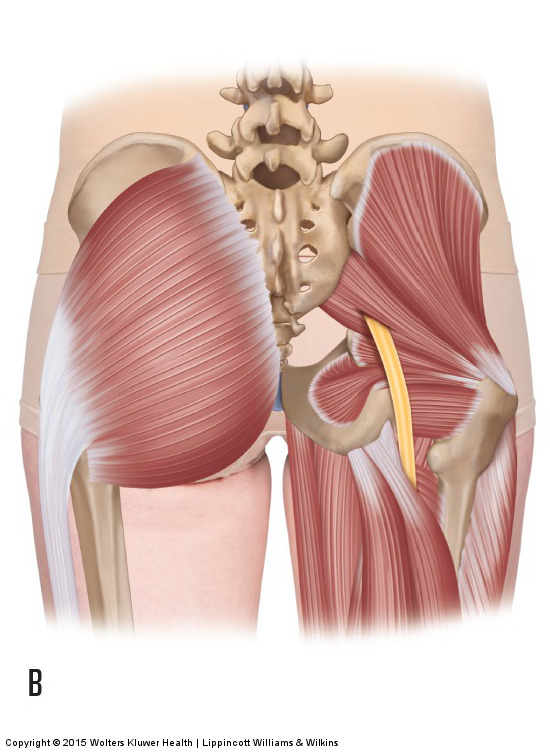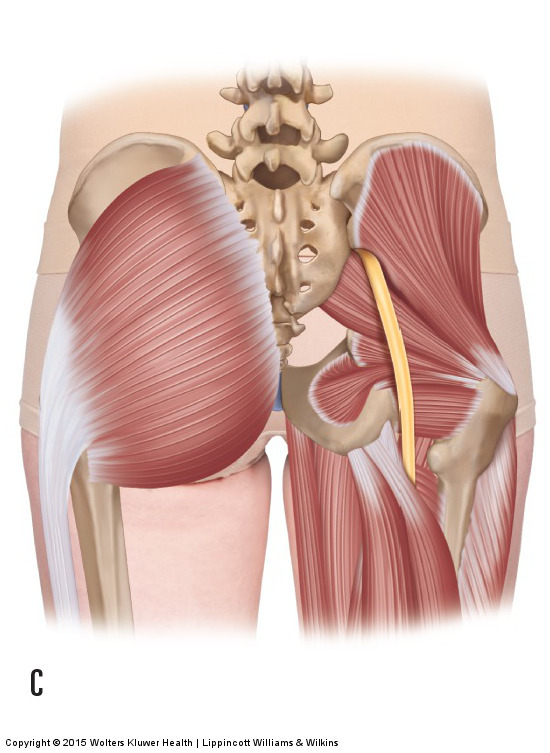Note: This blog post article is the seventh in a series of twelve articles on musculoskeletal conditions of the low back (lumbar spine) and pelvis. For the rest of the articles in the series, scroll to the end of this article.
Piriformis syndrome is a condition in which the piriformis muscle compresses the sciatic nerve, causing symptoms of sciatica into the lower extremity.
Description of Piriformis Syndrome



Figure 16. Relationship of the sciatic nerve to the piriformis. (A) The usual relationship is for the sciatic nerve to emerge from the internal pelvis into the gluteal region between the piriformis and the superior gemellus. (B, C) Sometimes, part or all of the sciatic nerve exits through the piriformis or above the piriformis, between it and the gluteus medius. Permission Joseph E. Muscolino. Manual Therapy for the Low Back and Pelvis – A Clinical Orthopedic Approach. 2015.
Normally, the sciatic nerve exits from the internal pelvis into the buttocks between the piriformis muscle and the superior gemellus muscle. However, approximately 10% to 20% of the time, part or all of the sciatic nerve either exits through the piriformis, or above it, between the piriformis and the gluteus medius (Fig. 16). Regardless of the relationship of the piriformis and sciatic nerve, if the muscle is tight enough, the nerve may be compressed, resulting in sciatica. This condition is often said to cause “pseudo sciatica”; however, this term does not make sense and shows a bias toward bony or disc impingement on the nerve. If compression of the sciatic nerve occurs and symptoms of sciatica are experienced, then regardless of the cause, it can be correctly termed sciatica.
Mechanism and Causes of Piriformis Syndrome
The piriformis muscle can become tight due to overuse. The piriformis acts as a lateral rotator of the thigh at the hip joint as well as a contralateral rotator of the pelvis at the hip joint (contralateral rotation of the pelvis occurs when planting and cutting [planting the foot and pivoting to change directions] during sports). The piriformis is also functionally important toward stabilizing the sacrum at the sacroiliac joint and stabilizing the hip joint.
Note: Treatment Considerations in Brief for Piriformis Syndrome
Because piriformis syndrome is a condition of muscular origin, it makes sense that it will respond well to soft tissue manipulation. Moist heat, massage, and stretching are all very beneficial. Pin and stretch technique is particularly effective when working on the piriformis. Click here for more on manual therapy treatment of Piriformis Syndrome.
(Click here for an article on another deep lateral rotator of the hip joint, the quadratus femoris.)
This blog post article is the seventh in a series of twelve articles on musculoskeletal conditions of the low back (lumbar spine) and pelvis.
The articles in this series are:
- Hypertonic / tight muscles
- Myofascial trigger points
- Joint dysfunction
- Sprains and strains
- Sacroiliac joint injury
- Pathologic disc conditions and sciatica
- Piriformis syndrome
- Degenerative joint disease (DJD)
- Scoliosis
- Lower crossed syndrome
- Facet syndrome
- Spondylolisthesis


